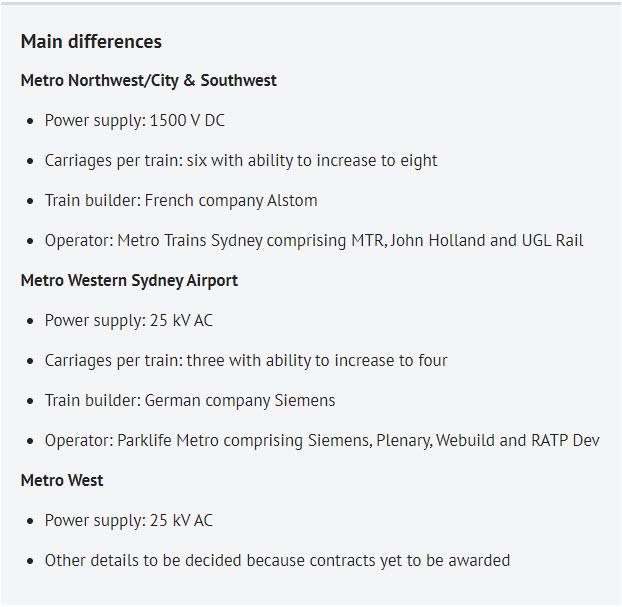Both the Sydney Morning Herald and the ABC have followed up some of the issues raised in my two-part series on the way that decisions of the previous NSW state government have ensured that Sydney Metro will be far from the integrated network everyone thought it would be.
The headline of the SMH article published on 29 May 2023 captured the theme of my series: Why Sydney will end up with three incompatible metro train lines. The reporter, Matt O’Sullivan, summed up the substantial technical differences between the systems which I detailed in the series, including the fact that each line will be built and run by separate consortia.
This was followed up on the same day when I was interviewed on ABC Radio Sydney by the Afternoons presenter, Josh Szeps. In a wide-ranging conversation that ran for nearly 20 minutes we covered the key issues and also delved into the history behind the metro and its relationship to Sydney’s heavy rail network.
There has been a lot of feedback, particularly in response to the SMH article. By the following day the online version had generated over 350 comments, while eight letters to the editor relating to the article were also published. The overwhelming majority of these echoed my concerns about the previous government’s development of the metro “network” as three separate systems and some of the likely consequences.

On the other hand, a handful of the online responses sought to defend the previous government’s handling of this issue. The majority of these pointe out that lots of metro networks overseas operated successfully with lines that had different operators and/or incompatible technologies. They also noted that in these systems the lines are designed to be physically isolated from each other, with passengers rather than trains transferring between lines at interchange stations.
I attempted to deal with this perspective both in my series on the Sydney Metro and in my conversations Matt O’Sullivan and Josh Szeps, but I’ll reiterate my comments here. To take the second point first, I acknowledged that designing lines to operate independently makes a lot of sense, primarily because a train breakdown or other fault on one line does not affect operations on the rest of the system.
The use of incompatible technologies and trains for separate lines within the same system is quite a different matter. While this is also quite common in overseas metros, it usually reflects the fact that these systems expanded gradually. Lines were built at different times, sometimes decades or even a century apart, with system designs and the technologies used changing as they evolved over that time.
This is encapsulated in the history of the London Underground. The earliest “sub-surface”underground lines were built over 150 years ago using shallow cut-and-cover methods, so the first trains were actually bigger than their counterparts of the late 19th and early 20th century when deeper tunnels were dug. Due to the cost and complexity involved, the these tunnels were only a little over three metres in diameter (in other words, less than the width of the average single bedroom), which obviously constrained the design of the deep tube trains. In more recent years, modern tunnel boring machines have allowed the size of trains to be increased again.
Metro systems in other cities such as Boston, Berlin and Paris have similar stories. Boston’s first underground line was and still is essentially a light rail corridor, and to this day uses very different rolling stock to the other lines. Berlin has a mix of S-Bahn and U-Bahn lines, with the latter divided into wide and narrow profile trains, while Paris also has newer high-speed limited-stop RER lines which operate separately to the older metro system (which itself uses a mix of different technologies).
There is no question that these networks all operate successfully – but this does not make these incompatibilities desirable. It is difficult to achieve economies of scale when purchasing new rolling stock, for example, and the variety of inconsistent systems and equipment affects maintenance and staffing costs. It is highly unlikely that any of the current operators would seek to replicate these inconsistencies if they were designing their networks from scratch.
But that is effectively what the previous NSW state government did. I have outlined some of the rationale behind their decision-making in my metro series, but nothing can really justify the extent of unnecessary incompatibility that is being built into the system as a result – especially as at least two of the lines, Metro NW/City/SW and Metro WS Airport are planned to meet eventually to provide end-to-end services.
These lines will have different power supplies, different train lengths and – in an echo of the experience in London and Berlin – even different train widths. I won’t describe these further as they are covered in detail in my series, but the outcome is that the Metro WS Airport trains are highly unlikely to ever provide a through service to the Sydney CBD or to any other major centre except, possibly, Bankstown. And as I also noted, the limited length of these trains, which it looks like will be baked into the design of the stations and other infrastructure, will also permanently constrain the capacity of the airport line.
This strikes me as a particularly perverse outcome, especially considering the huge potential of this line to have a key role in outer Western Sydney above and beyond servicing the airport. I’ll return to this and some of the other issues the current state government should urgently consider in its review of the metros in a future post.


Government ineptitude of the absolute highest order.
LikeLike